Summary
Since 2005, the NIST Fire Research Division has engaged in a collaborative research effort with the Office of Nuclear Regulatory Research of the US Nuclear Regulatory Commission (US NRC) to support Nuclear Power Plants implementation of risk-informed performance-based fire protection programs. As plants began to implement these strategies it became apparent that electrical enclosure fire scenarios dominated fire risk contributions across most plant in the fleet and suggested research could improve realism in the modes and allow end users to ensure adequate protection from fire hazards. Over the past two decades, significant effort and resources have thus been dedicated to refining the methods, tools, and data used to model electrical enclosure fires in fire Probabilistic Risk Assessment (PRA).
Description
Objective:
To provide measurement data and analysis tools that enable accurate, efficient, probabilistic risk assessments for fire scenarios in nuclear power plants.
Recent Research:
Brief descriptions and links to technical reports developed from recent NIST/NRC collaborations focused on Cable Fires and Fires in Electrical Enclosures are provided below. An NRC project page highlighting the collaborative research program focused on High Energy Arc Faults (HEAF) is available online at https://www.nrc.gov/about-nrc/regulatory/research/fire-research/heaf-research.html. Further information about the US NRC’s Fire Research Program is available online: https://www.nrc.gov/about-nrc/regulatory/research/fire-research.html.
Ongoing Development and Future Work
As the nuclear[1] and general fire protection[2,3] industries continue to expand their use of risk-informed, performance-based design principles, simple pass/fail criteria of standard fire tests are no longer sufficient to provide the granular level of risk information needed to support effective decision making. There is a growing need for verified and validated design tools (i.e., fire models) that can predict relevant fire behavior and its consequences. A primary focus of the Engineered Fire Safe Products (EFSP) Project is to support this general objective.
Fire Modeling
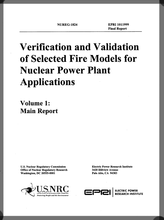
One key element in risk-informed and performance-based fire protection is the availability of verified and validated (V&V) fire models that can reliably estimate the effects of fires. The U.S. NRC, together with the Electric Power Research Institute (EPRI) and the National Institute of Standards and Technology (NIST), conducted a research project to verify and validate five fire models (including the NIST Fire Dynamics Simulator, FDS, and Consolidated Fire Growth and Smoke Transport Model, CFAST) that have been used for NPP applications. The results of this effort are documented in a seven-volume report, NUREG-1824 (EPRI 1011999), Verification & Validation of Selected Fire Models for Nuclear Power Plant Applications.
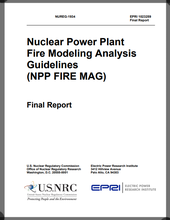
NUREG-1934, “Nuclear Power Plant Fire Modeling Analysis Guidelines (NPP FIRE MAG” describes the implications of the V&V results for fire model users. The features and limitations of the five fire models documented in NUREG-1824 (EPRI 1011999) are discussed relative to NPP fire hazard analysis (FHA). Finally, the report provides information on the use of fire models in support of various commercial NPP fire hazard analysis applications.
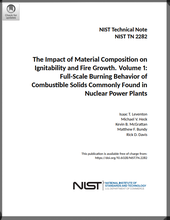
NIST Technical Note 2282[5] presents a step forward as part of a collaborative research effort to advance these models and validate their ability to enable accurate, efficient, and reliable prediction of fire development (e.g., burning of combustible solids in electrical enclosures) based on knowledge of the materials contained within and simulation of the relevant condensed- and gas-phase processes controlling their burning behavior. This general objective is the primary focus of the Engineered Fire Safe Products (EFSP) Project and the development of the NIST Material Flammability Database.
Electrical Enclosure Fires
In a recent review of all fire events reported in US NPPs between 1990 and 2011 [6], it was found that 13.5 % (269 out of 1998) occurred in electrical enclosures. Of these fires, 8.2 % and 39.4 % were reported as “Challenging” or “Potentially Challenging,” respectively. In this reporting system, “Challenging” fire events are those that had “an observable and substantive effect on the environment outside the initiating source;” “Potentially Challenging” events “were not judged to be [challenging] events, but … could have led to fire growth, fire spread, equipment damage or cable damage beyond the fire ignition source had the circumstances of the fire event been different” [7]. Collectively, these results demonstrate why electrical cabinets (and medium voltage switchgear [600 V to 69 kV]) are “commonly identified in fire PRAs [probabilistic risk assessments] as one of the important sources of fire ignition in nuclear power plants” [8].
In 2005, the Electric Power Research Institute (EPRI) and the NRC’s Office of Nuclear Regulatory Research (RES) issued a joint technical report (EPRI 1011989, NUREG/CR-6850 [9]), presenting methods and data for conducting a fire probabilistic risk assessment (fire PRA); NUREG/CR-6850 covered a wide range of fire hazards, including electrical enclosures. This report represented the state of the art in the mid-2000s and it was the first fire PRA methodology to use probability distributions for heat release rate values, as opposed to the point values of existing PRA methodologies.
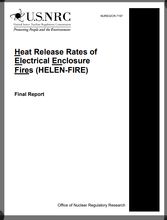
In 2013, a series of experiments were sponsored by the Nuclear Regulatory Commission’s Office of Nuclear Regulatory Research (NRC-RES) and conducted by the National Institute of Standards and Technology (NIST) at the Chesapeake Bay Fire Test Detachment (CBD) of the Naval Research Laboratory to obtain additional data to support re-quantification of HRR estimates for electrical enclosures. This testing effort used electrical enclosures removed from a nuclear facility, and electrical cables and panel wiring representative of those commonly found in U.S. nuclear power plants (NPPs). In total, 112 individual fire tests were conducted, and the result of this effort is documented in NUREG/CR-7197, “Heat Release Rates of Electrical Enclosure Fires (HELEN-FIRE)”.
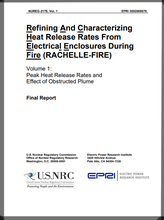
In 2016, a joint NRC/EPRI working group devised an enhanced methodology for modeling electrical enclosure fires, which included classification of electrical enclosures in terms of function, size, contents, and ventilation; determination of peak heat release rate (HRR) probability distributions considering specific electrical enclosure characteristics; and development of a method to account for the impact of the enclosure on the vertical thermal zone of influence (ZOI) above the enclosure during fire. This enhanced methodology is documented in NUREG-2178 Vol. 1 (EPRI 3002005578), “Refining and Characterizing Heat Release Rates From Electrical Enclosures During Fire (RACHELLE-FIRE)”.
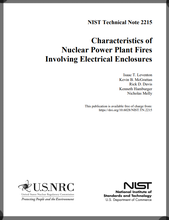
This report provides an overview of the characteristics (e.g., ignition sources, severity, and damage type) of electrical enclosure fires that occurred in US nuclear power plants between 1990 and 2011, as reported in the Fire Events Database (FEDB). Key findings include: number and types of events, causes of ignition, and resulting damage/severity. https://doi.org/10.6028/NIST.TN.2215

This report provides an overview of measurements (e.g., heat release rate, gaseous species production, and flame-to-surface heat transfer) and visual observations obtained from a series of 66 full-scale fire growth experiments conducted on 18 unique combustible solids including: natural and synthetic polymers, copolymers, fiberglass-reinforced composite materials, porous polymer foams, and electrical cables. The key research question addressed by this project is: how does material composition affect ignition, fire growth rate, and peak fire size in largescale fire experiments designed to represent an electrical enclosure with a simplified fuel loading configuration. https://doi.org/10.6028/NIST.TN.2282
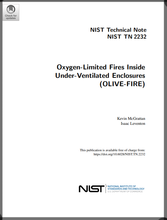
In 2023, an experimental campaign was conducted (a NIST/NRC collaboration) to measure the HRR of fires burning in steel enclosures with limited ventilation (Oxygen-Limited Fires Inside Under-Ventilated Enclosures, OLIVE-FIRE~\cite{mcgrattan2022oxygen}). The objective of this study was to validate a simple empirical model that predicts the maximum heat release rate of a fire within a closed compartment as a function of its ventilation openings. https://www.nist.gov/publications/oxygen-limited-fires-inside-under-ventilated-enclosures-olive-fire
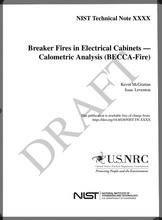
This report (in preparation) documents a series of fire experiments performed within steel electrical enclosures. The objective is to measure the heat release rates and qualitatively understand the burning behavior of circuit breaker fires within closed steel enclosures when ignited by a source representative of a high energy arc fault (HEAF).
Cable Fires
The Cable Heat Release, Ignition, and Spread in Tray Installations during Fire (CHRISTIFIRE) experimental program is an effort to quantify the mass and energy released from burning electrical cables. The program included fire tests on grouped electrical cables to enable better understanding of the fire hazard characteristics, including the ignition, heat release rate, and flame spread.
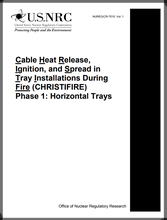
PHASE 1 of CHRISTIFIRE included experiments ranging from micro-scale to full scale to measure (1) properties controlling material flammability response (e.g., Heat of combustion, Pyrolysis temperature, Heat release capacity, and Solid residue yield), (2) the full-scale burning rate of cables when installed in ladderback trays, and (3) the impact of vertical tray spacing, tray width, and tray fill on full scale burning behavior.
During Phase 1 of CHRISTIFIRE, the NRC developed a simple model of flame spread in horizontal tray configurations (called Flame Spread over Horizontal Cable Trays (FLASHCAT]) that makes use of semi-empirical estimates of lateral and vertical flame spread and measured values of combustible mass, heat of combustion, heat release rate per unit area, and char yield. https://www.nist.gov/publications/cable-heat-release-ignition-and-spread-tray-installations-during-fire-christifire-0
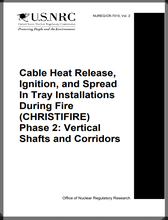
Phase 2 of the CHRISTIFIRE project examined flame spread on cables in trays oriented in the vertical direction (17 experiments, two adjacent trays) and the impact of an enclosure on cable flame spread in multiple horizontal trays (10 experiments, with trays located in a simulated hallway relatively close to the wall and ceiling). Bench-scale experiments were also performed using a cone calorimeter in which 10 cm (4 in) by 10 cm (4 in) cable segments were exposed to a relatively high heat flux to determine their burning rate, heat of combustion, and other properties.
The purpose of both sets of full-scale experiments was to determine the heat release and spread rates of burning cables in a variety of realistic configurations.https://www.nist.gov/publications/cable-heat-release-ignition-and-spread-tray-installations-during-fire-christifire-phase
References
- National Fire Protection Association. Performance-based standard for fire protection for light water reactor electric generating plants. Technical Report NFPA 805, 2020.
- Ezekoye, O.A., Hurley, M.J., Torero, J.L., and McGrattan, K.B., “Applications of heat transfer fundamentals to fire modeling,” Journal of Thermal Science and Engineering Applications, 2013
- Alvarez, A., Meacham, B.J., Dembsey, N.A., Thomas, J.R., ”Twenty years of performance-based fire protection design: challenges faced and a look ahead,” Journal of Fire Protection Engineering, 23(4):249–276, 2013
- NRC/EPRI. Verification and validation of selected fire models for nuclear power plant applications. NUREG NUREG-1824 // EPRI 1011999, volumes 1-7, Nuclear Regulatory Commission, Washington, D.C., 2007.
- Leventon, I.T., Heck, M. V., McGrattan, K.B., Bundy, M.F., and Davis, R.D., ‘The Impact of Material Composition on Ignitability and Fire Growth. Volume 1: Full-Scale Burning Behavior of Combustible Solids Commonly Found in Nuclear Power Plants’ NIST Technical Note 2282, 2024. https://doi.org/10.6028/NIST.TN.2282
- I.T. Leventon, K.B. McGrattan, R.D. Davis, K. Hamburger, and N. Melly. Characteristics of nuclear power plant fires involving electrical enclosures. NIST Technical Note 2215, National Institute of Standards and Technology, 2021. https://doi.org/10.6028/NIST.TN.2215
- R. Wachowiak and A. Lindeman. The updated fire events database: Description of content and fire event classification guidance. Technical Report 1025284, Electric Power Research Institute, Palo Alto, California, July 2013
- S.P. Nowlen, M. Kazarians, and F. Wyant. Risk methods insights gained from fire incidents. NUREG NUREG/CR-6738, Nuclear Regulatory Commission, Washington, D.C., 2001.
- Electric Power Research Institute (EPRI) and Office of Nuclear Regulatory Research (RES) U.S. Nuclear Regulatory Commission. Fire pra methodology for nuclear power facilities volume 2: Detailed methodology. NUREG EPRI TR-1011989 and NUREG/CR-6850, Nuclear Regulatory Commission, Rockville, MD, 2005

